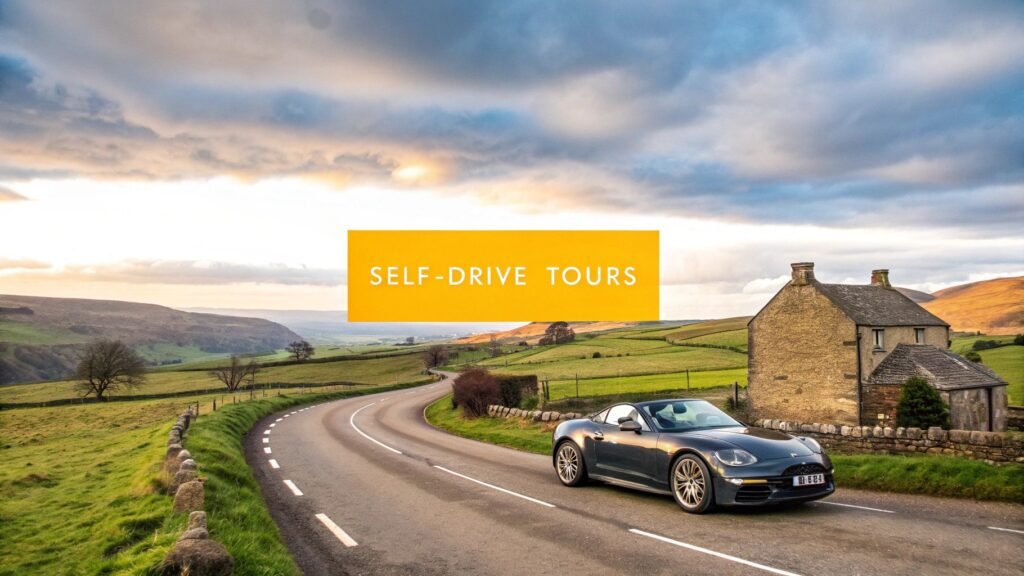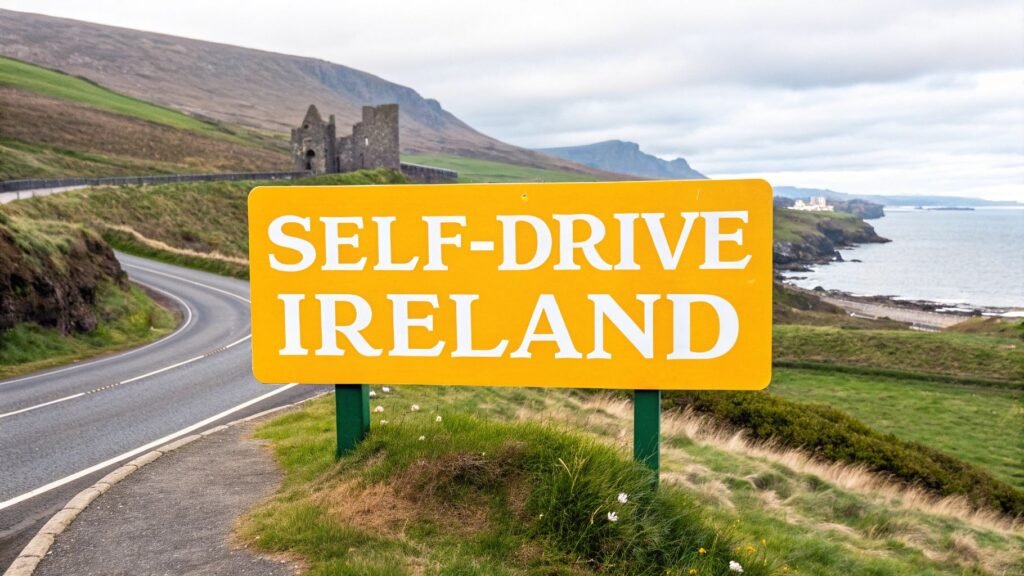Let’s be honest, the best road trips aren’t just about getting in the car and driving. Planning a scenic road trip is born from a blend of exciting daydreams and smart, practical thinking. It’s about more than just picking a spot on the map; it’s about piecing together a journey that feels like yours.
This is where you marry the dream of winding country lanes and stunning coastal views with the real-world logistics. Getting this first part right is the secret to a smooth, unforgettable adventure.
Your Starting Point for an Unforgettable UK Road Trip
A truly great road trip starts long before you even touch the car keys. It begins with that initial spark – a picture of Scotland’s epic mountain passes or the thought of cruising through Cornwall’s sun-drenched fishing villages. The real magic, though, is in turning that spark into a solid plan. This is where you lay the foundation for everything.
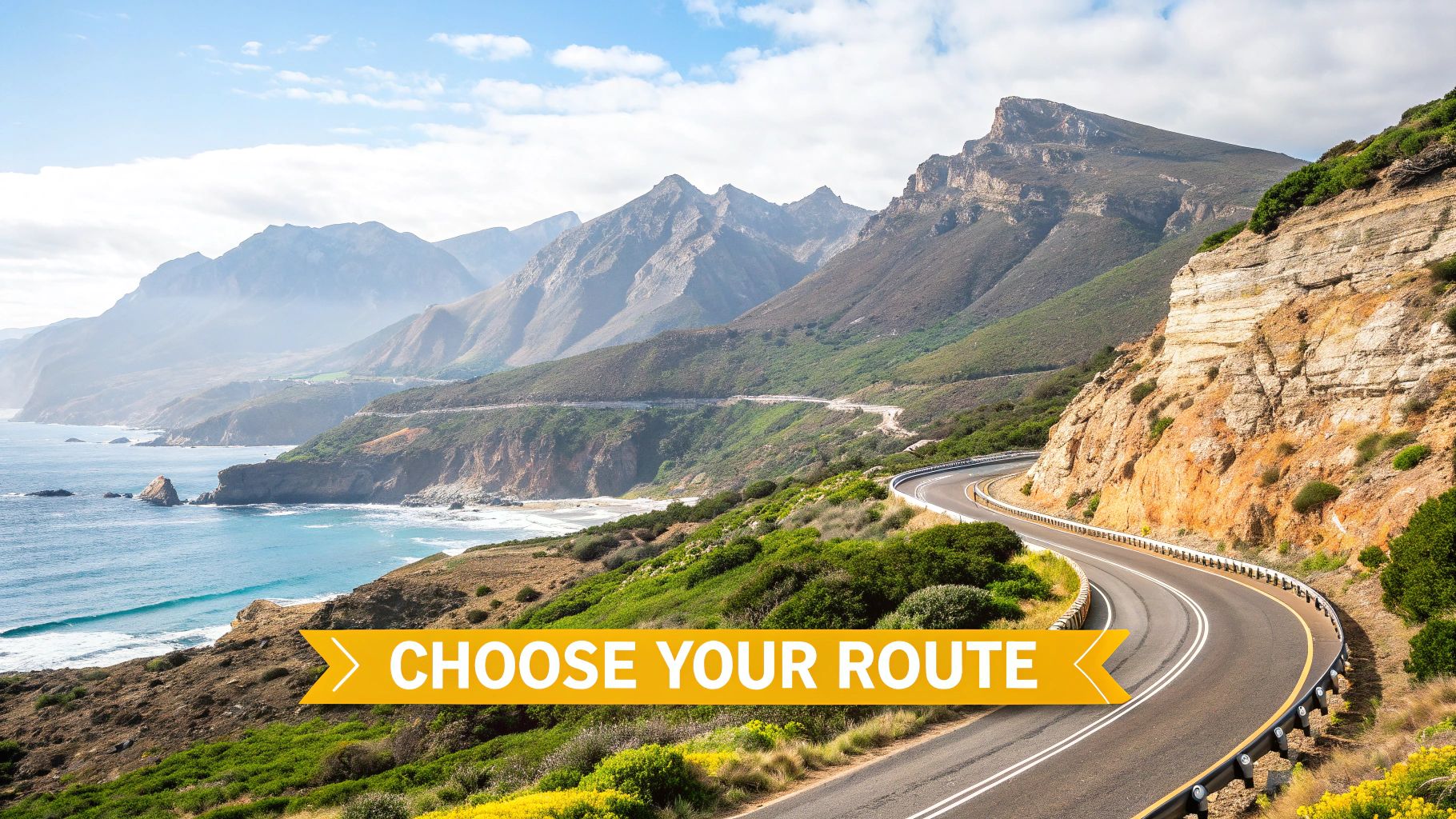
Forget about mapping out every single second of your trip. Right now, it’s all about the big picture. Think of it as sketching out the blueprint for your adventure, getting the main structure in place before you worry about the finer details.
What Kind of Trip Are You Really After?
First things first, what sort of vibe are you going for? Are you picturing the wild, dramatic beauty of the North Coast 500, or is the gentle, honey-stone charm of the Cotswolds more your speed? Your personal taste is the compass that will guide every other choice you make.
From my experience, a successful trip rests on three key pillars:
- The Perfect Route: This is about finding a drive that genuinely excites you. Are you a history buff, a foodie, a hiker, or all three? Your route should reflect that.
- A Trusty Vehicle: You need to know your car is up to the task. A quick check of the basics now will save you a massive headache later on.
- A Flexible Plan: This is crucial. You want to have your must-see spots locked in, but leave enough wiggle room to follow a random sign to a hidden beach or stop for an unplanned cream tea.
A good road trip plan doesn’t box you in—it sets you free. It gives you a solid framework, so you have the confidence to take that spontaneous detour or pull over just to soak in an amazing view.
To help you get your head around the process, here’s a quick look at the essential phases you’ll be working through.
Key Stages of planning a scenic Road Trip
| Planning Stage | Key Objective | Example Action |
|---|---|---|
| 1. The Big Idea | Define the overall vision and feel of your trip. | Decide between a coastal adventure (e.g., Atlantic Highway) or a mountain escape (e.g., Snowdonia). |
| 2. Route & Itinerary | Map out a realistic route with key stops and activities. | Plot your daily driving distances and book your first and last night’s accommodation. |
| 3. Budget & Bookings | Set a clear budget and book essential accommodation and vehicle hire. | Calculate daily costs for fuel, food, and lodging. Book popular hotels in advance. |
| 4. Final Preparations | Get your vehicle checked, pack your bags, and sort out the details. | Check tyre pressure and oil levels; create a packing list for variable UK weather. |
This table gives you a bird’s-eye view, but we’re about to dive deep into each step. We’ll go from a vague idea of a “scenic drive” to a concrete, actionable plan that ensures everything else, from budgeting to packing, falls perfectly into place. Let’s get you ready for a brilliant, stress-free UK road trip.
Finding the UK’s Most Spectacular Driving Routes
The UK is packed with an incredible variety of landscapes, from the wild, windswept coasts of Scotland to the gentle, rolling hills of the South Downs. This is all about helping you find the perfect scenic drive for your trip, matching a route to your own travel style and what you genuinely love to do.
The first, and sometimes hardest, part of planning a road trip is simply deciding where to go. With so many amazing options, it’s easy to feel a bit lost. My advice? Don’t just pick a famous route from a list. Instead, think about the kind of experience you’re really after. Are you dreaming of exploring ancient castles and historic towns, or do you hear the call of dramatic mountain passes and rugged coastlines?
Match a Route to Your Interests
Let your passions steer the wheel. What gets you excited should be the foundation of your itinerary. A history buff will get a completely different thrill from a route than a keen hiker or a family looking for classic seaside fun.
Think about what kind of UK driving experience you’re craving:
- For the History Buff: The Heart of England is like a journey through a history book, with routes weaving between Shakespearean landmarks, imposing medieval castles, and grand stately homes. A ten-day trip here gives you plenty of time to explore at a relaxed pace. For a perfectly planned historical adventure, take a look at our Taste of England 8-Days Self-Drive Tour.
- For the Coastal Explorer: It’s hard to beat the raw beauty of Northern Ireland’s Causeway Coastal Route or Scotland’s legendary North Coast 500. These drives are all about breathtaking cliffs, powerful sea stacks, and postcard-perfect fishing villages.
- For the Mountain Lover: Head straight for Wales. Routes like the Cambrian Way slice through mountainous national parks, delivering jaw-dropping vistas and exciting drives that reward you with unforgettable scenery.
How Your Trip Duration Shapes Your Choice
The amount of time you have is, of course, a huge factor. You can have a brilliant road trip in just a weekend, but having a bit more time opens up some truly epic routes.
A short trip of 2-3 days is ideal for getting to know one specific area really well, like the Cotswolds or the Peak District.
With a full week, you can plan a more extensive tour. Think about tackling a major chunk of the Scottish Highlands or tracing the stunning coastlines of Cornwall and Devon.
If you’re lucky enough to have ten days or more, you can start thinking about cross-country adventures, linking several regions together for the ultimate UK road trip.
The best route isn’t always the most famous one. It’s the one that clicks with how you love to travel. Choosing a drive that genuinely excites you is the secret to a journey you’ll never forget.
If capturing stunning photos is high on your list, it’s worth planning some specific stops. For instance, you could weave some of the best scenic viewpoints in Northumberland into your itinerary. A little planning can turn a great drive into a visual masterpiece, ensuring you really capture the soul of the UK’s incredible landscapes.
Crafting Your Itinerary and Road Trip Budget
Let’s be honest, the best road trips aren’t just about the destination; they’re about the journey itself. Finding that perfect balance between a solid plan and the freedom to pull over for an amazing view is the real secret. This is where you turn a line on a map into a day-by-day adventure, all while making sure your wallet can keep up with your wanderlust.
Think of your budget not as a restriction, but as your ticket to a stress-free trip. Knowing you’ve got the essentials covered frees you up to enjoy those spontaneous moments without worrying about the cost. Similarly, having a rough idea of where you’ll be each night means you won’t be desperately searching for a room in the dark, especially when you’re in a popular spot.
Mapping Your Daily Drives
One of the biggest mistakes I see people make is trying to cover too much ground too quickly. Scenic drives are meant for meandering, not for setting land-speed records. Those charming country lanes, single-track roads, and countless photo opportunities all take time.
As a general rule, I’d suggest aiming for 3-5 hours of actual driving each day. That leaves plenty of breathing room for a long lunch, an unplanned detour to a hidden cove, or just soaking in the atmosphere at your destination.
A great way to structure your day is to think in terms of highlights rather than strict schedules:
- Morning: Set off from your B&B and head towards a major landmark or viewpoint.
- Midday: Spend a few hours exploring, grab a bite to eat, and maybe check out a local museum or walk.
- Afternoon: Enjoy a shorter, relaxed drive to your next overnight stop, giving you time to check in and unwind before dinner.
Building a Realistic Road Trip Budget
Your budget is the foundation of your entire trip. To avoid any nasty surprises, it’s best to break down your spending into a few key areas.
A word of advice: don’t just budget for the obvious costs like petrol and hotels. It’s the little things—the daily coffees, car park fees, and entry tickets—that can really sneak up on you. I always recommend adding a contingency fund of about 10-15% of your total budget for those just-in-case moments.
Here’s a quick checklist of costs to think about:
- Fuel/EV Charging: Work out your total mileage and use your car’s average consumption to get a rough fuel cost. If you’re in an electric vehicle, it’s smart to map out charging points and their fees beforehand.
- Accommodation: This will probably be your biggest single expense. Costs can vary wildly, from a simple campsite to a cosy B&B or a boutique hotel.
- Food & Drink: How do you plan to eat? Dining out for every meal adds up, but packing a few picnics can be a great way to save money and enjoy the scenery.
- Attractions & Activities: Do a quick search for the entry fees to any castles, gardens, or distilleries on your must-see list.
- Miscellaneous: Don’t forget to set aside a little something for souvenirs, road tolls, and parking.
Let’s take a real-world example, like Scotland’s iconic North Coast 500. This 516-mile route has an estimated petrol cost of roughly £88. You’ll find around 152 affordable accommodation options under £150 a night, and with 65 EV charging points, it’s a brilliant example of a classic road trip that’s fully equipped for modern travellers.
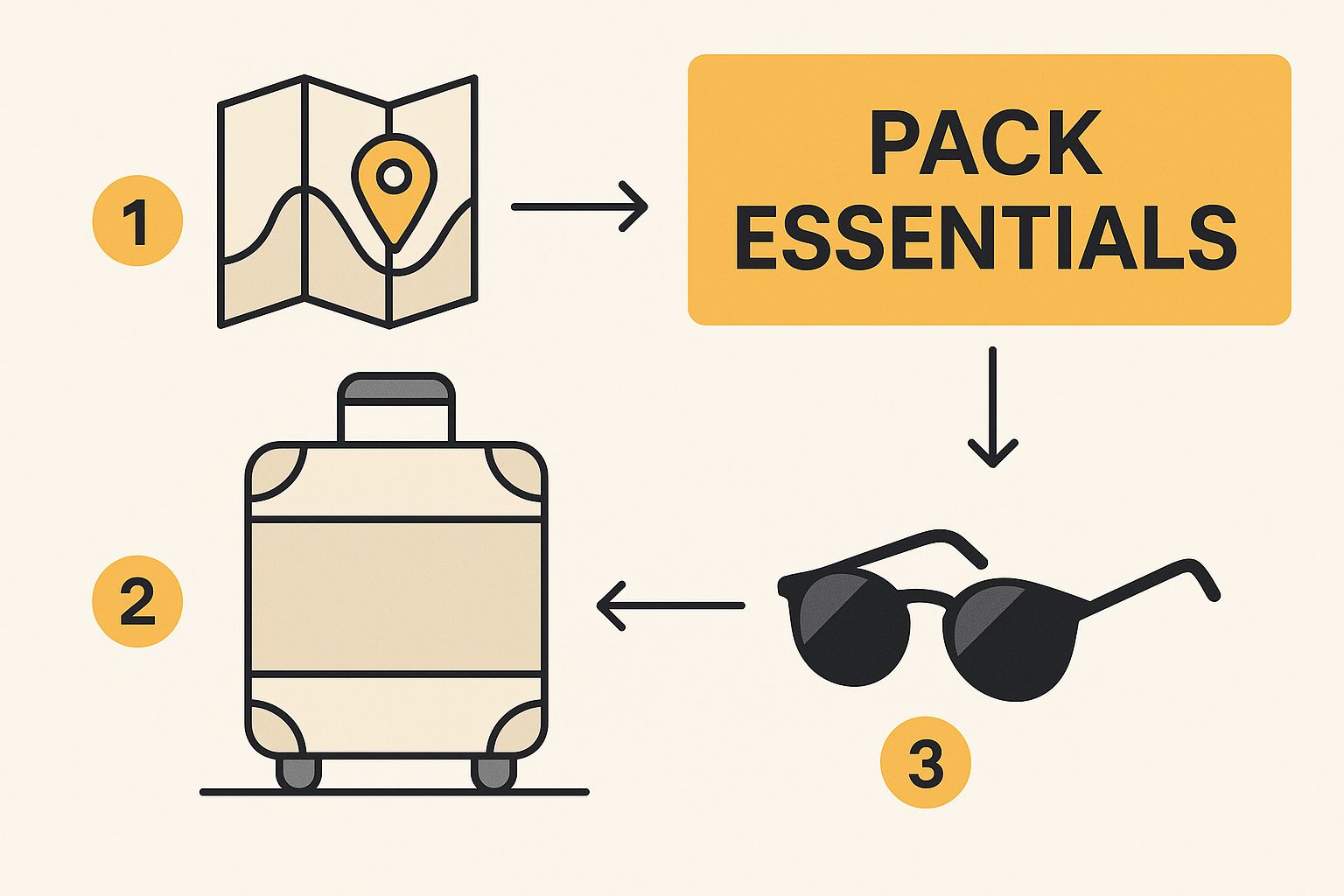
Seeing it all laid out like this really drives home the point that a great trip is a mix of good gear and smart planning. If you’re looking to take the guesswork out of the logistics, our expertly planned self-drive tours handle all the details, leaving you free to simply enjoy the open road.
Prepping Your Vehicle and Packing Smart
https://www.youtube.com/embed/r6X4iIHTbHc
On a road trip, your car is so much more than just a way to get from A to B. It’s your mobile base camp, your luggage hauler, and your trusty companion for the entire adventure. Before you even think about what to pack, the single most important thing you can do is give your vehicle a proper, thorough check-up. Honestly, a brilliant journey starts with a well-maintained car.
First things first, let’s cover the simple but absolutely vital basics. Check all your fluid levels—we’re talking oil, coolant, and windscreen washer fluid. These are easy enough for anyone to top up and they’re crucial for keeping your engine running smoothly over long distances. It’s also a great idea to give your tyres a once-over and maybe pack a portable car tire inflator pump for those just-in-case moments. Keeping your tyres properly inflated isn’t just safer; it saves you money on fuel, too.
Essential Vehicle Pre-Trip Checks
Spending a few minutes on these checks now can genuinely save you hours of stress and hassle later on. Don’t be tempted to skip them.
- Tyre Health: It’s not just about pressure. Have a look at the tread depth. While the legal minimum in the UK is 1.6mm, I’d always recommend having a bit more than that for the peace of mind a long trip demands.
- Lights and Electrics: Grab a friend or family member for a two-minute check. Make sure all your lights are working as they should – headlights (dipped and full beam), indicators, brake lights, and fog lights.
- Brakes: Are they making any strange squeaking or grinding sounds? If you have even the slightest doubt about your brakes, please get them looked at by a professional. It’s not worth the risk.
- Emergency Kit: Make sure your emergency kit is in the boot and complete. At a minimum, you’ll want a warning triangle, a high-vis jacket, jump leads, and a basic first-aid kit.
Smart Packing for UK Weather and Small Spaces
With the car sorted, you can turn your attention to what goes inside. Packing for a UK road trip is a bit of an art, mainly thanks to our wonderfully unpredictable weather. The secret? Layers. One day you could be soaking up the sun on a beach in Cornwall, and the very next you might be driving through a misty downpour in the Scottish Highlands.
Forget the idea of ‘packing light’. The goal is to ‘pack smart’. Your focus should be on versatile items you can layer. A good waterproof jacket, a warm fleece, comfortable walking shoes, and a mix of t-shirts and long-sleeved tops will see you through almost any situation the UK weather throws at you.
To stop your car from descending into chaos, try using packing cubes or even just a few separate bags for different things. Having one for clothes, one for toiletries, and another for snacks and drinks makes finding what you need a breeze. No more emptying the entire boot at a service station just to find a packet of crisps.
And finally, think about what you’ll need during the day. I always keep a “day bag” in the front with me. It holds my phone charger, a power bank, sunglasses, any medication, and a water bottle. This tiny bit of organisation makes life on the road so much less stressful, letting you focus on what really matters: the stunning views ahead.
Making the Most of Your Time on the Road
Once your route is mapped and your car is ready to go, the real adventure starts. This is where a well-thought-out plan blossoms into a collection of brilliant memories. You’ve got the freedom of the open road, but a few insider tips will help you squeeze every last drop of enjoyment from your journey, especially on the UK’s wonderfully unique—and sometimes tricky—scenic routes.
Let’s be honest, many of Britain’s most stunning drives, from the hedgerow-lined lanes of Cornwall to the dramatic passes of the Lake District, are on narrow country roads. Some are even single-track. Knowing how to handle these with confidence is crucial.
The golden rule? Always be prepared to stop. Keep your eyes peeled for the designated passing places dotted along the road. Be ready to pull in, or even reverse to a wider spot if you have to. A simple, friendly wave to a driver who lets you pass is customary and always appreciated.
Embracing Spontaneity and Hidden Gems
While it’s good to have your main stops planned, the real magic of a road trip often lies in the detours you never expected to take. Give yourself permission to be spontaneous. See a quirky hand-painted sign pointing to a historic ruin or a secluded beach? Go for it. Some of my best travel stories have started with an impromptu turn down an unknown lane.
It’s all about striking a balance between driving time and exploring time. You don’t want to spend the entire day cooped up in the car. I’ve found a good rhythm is to use the mornings for driving to the next key area. Then, I dedicate the afternoons to exploring on foot, whether that’s pottering around a charming village or stretching my legs on a short coastal walk. For those venturing into England’s capital, our Royal Indulgence London tour is built around this very idea, mixing iconic sights with plenty of time for your own discoveries.
The most memorable parts of a journey are often the ones you didn’t plan. Don’t just stick to the main road; allow yourself to get a little lost. It’s often on the side roads where you’ll find the most authentic pubs, the quietest viewpoints, and the real character of a region.
Capturing the Moment and Travelling Sustainably
Fantastic photos are a huge part of remembering a scenic drive. For the best shots, it’s all about the light. The “golden hours”—that magical time just after sunrise and before sunset—cast a soft, warm glow that makes landscapes come alive. And please, don’t just snap pictures from inside the car! Pull over somewhere safe, get out, and find a more compelling angle. You’ll be amazed at the difference it makes.
As you explore, it’s also important that we all travel responsibly.
- Leave No Trace: It’s simple—take all your rubbish with you.
- Support Local: Buy from farm shops, eat in independent pubs, and spend your money with local artisans. It makes your trip more authentic and directly benefits the communities you’re enjoying.
- Respect the Environment: Stick to marked paths and be mindful of wildlife, especially when you’re in National Parks and other protected areas.
The UK is absolutely brimming with incredible driving routes that show off its amazing diversity. You could be winding through the dramatic limestone cliffs of Cheddar Gorge in Somerset one day and marvelling at the iconic Jurassic Coast in Dorset the next. Further north, Scotland’s North Coast 500 serves up rugged coastal panoramas, while the Cambrian Way in Wales is a dream for anyone who loves mountainous scenery. With more and more amenities like EV charging stations popping up, these routes are more accessible than ever, blending classic adventure with modern convenience. To get your imagination firing, you can explore some of the UK’s best road trips on TheWeek.com.
Your Road Trip Questions, Answered
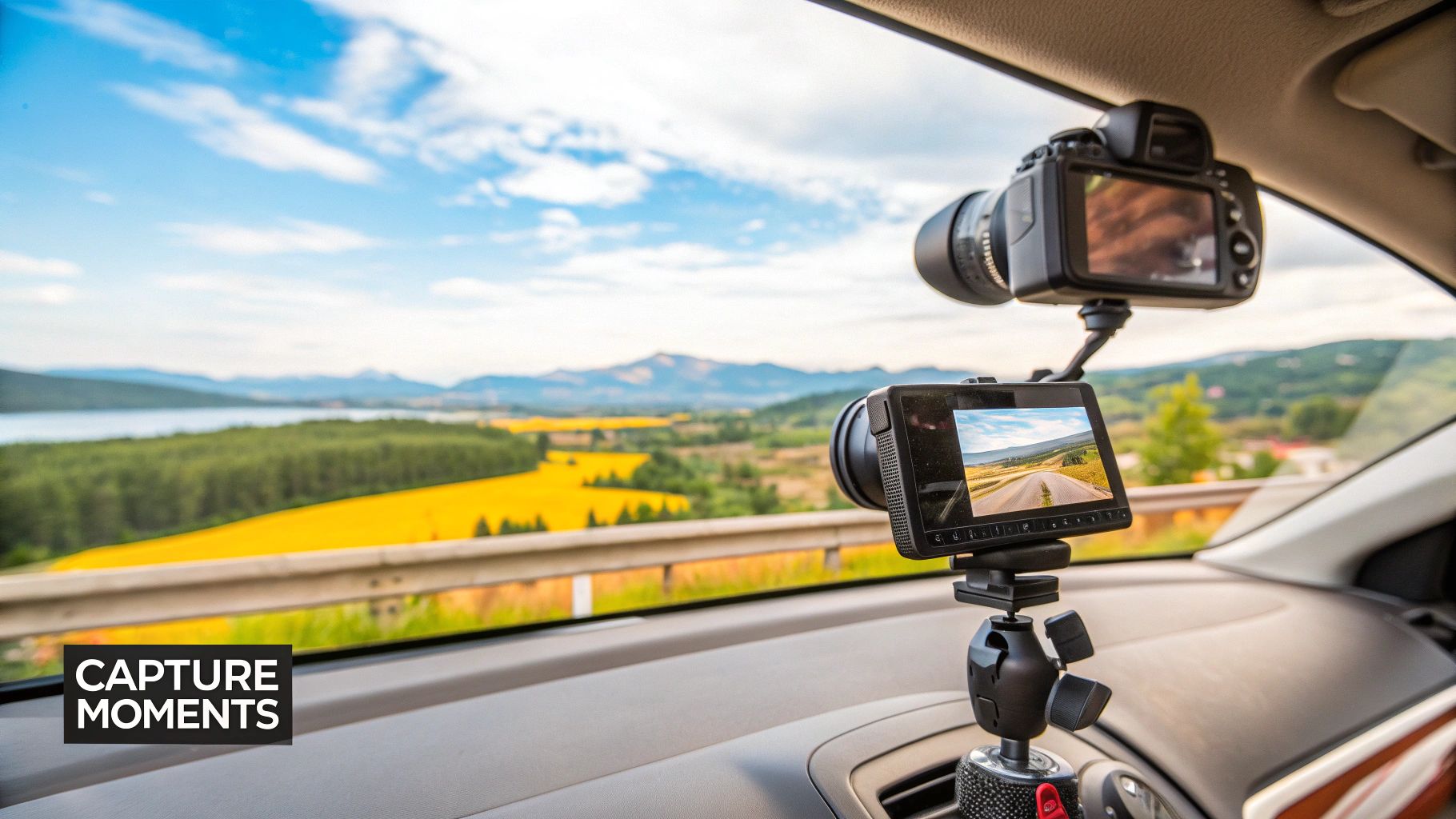
Even the most meticulously planned road trip can leave you with a few last-minute questions. That’s completely normal. Let’s tackle some of the common queries we hear all the time, giving you that final bit of confidence before you turn the key and start your adventure.
Think of this as a quick chat about the practicalities. From picking the perfect season to navigating those tiny country lanes, here are the straightforward answers you’re looking for.
When’s the Best Time for a UK Road Trip?
This is a big one, as your timing really shapes the whole experience. While the summer holidays might seem like the obvious choice, I’ve always found the real magic happens in the shoulder seasons.
Consider late spring (May-June) or early autumn (September-October). You’ll get the best of both worlds: the weather is generally mild, you still have plenty of daylight for exploring, and the roads and sights are far less crowded than in July and August. Plus, the scenery is arguably at its peak – think of the vibrant greens of spring or the gorgeous golden hues of autumn.
How Do I Find Those Unique, Off-the-Beaten-Path Stops?
The most memorable moments often come from the places you stumble upon by accident. While guidebooks are a great starting point, finding those truly special spots means thinking a little differently.
- Go Old-School: Get a proper physical map, like an Ordnance Survey map. They’re brilliant for showing hidden footpaths, ancient ruins, and tiny hamlets that digital maps often overlook.
- Chat with the Locals: This is my favourite trick. The person pulling your pint at the pub or serving you in the village shop knows the area inside out. Ask them for their favourite viewpoint or a quiet walk – their tips are often pure gold.
- Use Your Phone Wisely: Google Maps has an ‘Explore’ feature that can be surprisingly useful for digging up local cafés or nature spots that don’t make it into the mainstream travel guides.
A quick but crucial tip: Don’t count on having a phone signal everywhere, especially in the national parks. Download offline maps for your entire route before you set off. A portable power bank is non-negotiable, and chucking a physical road atlas in the boot is the ultimate safety net.
Are Campervans a Good Idea for UK Scenic Routes?
A campervan can be an amazing way to travel, offering incredible freedom. But you have to be honest about the roads you’ll be driving.
Many of the UK’s most scenic routes—especially in the Scottish Highlands, the Lake District, and Cornwall—are notoriously narrow. We’re talking single-track lanes with infrequent passing places. If you’re not used to driving a large vehicle, navigating these can be seriously stressful.
Before you commit to a campervan, look up your route on Google Street View and ask yourself if you’re comfortable with those tight squeezes. Sometimes, a smaller, more nimble car is simply the better, more relaxing choice for getting to those truly remote beauty spots.
Ready to turn your dream UK road trip into a reality without the planning headaches? At BTOURS, we craft unforgettable self-drive tours that handle all the details for you. Explore our curated journeys at https://www.btours.com and find your perfect adventure.


